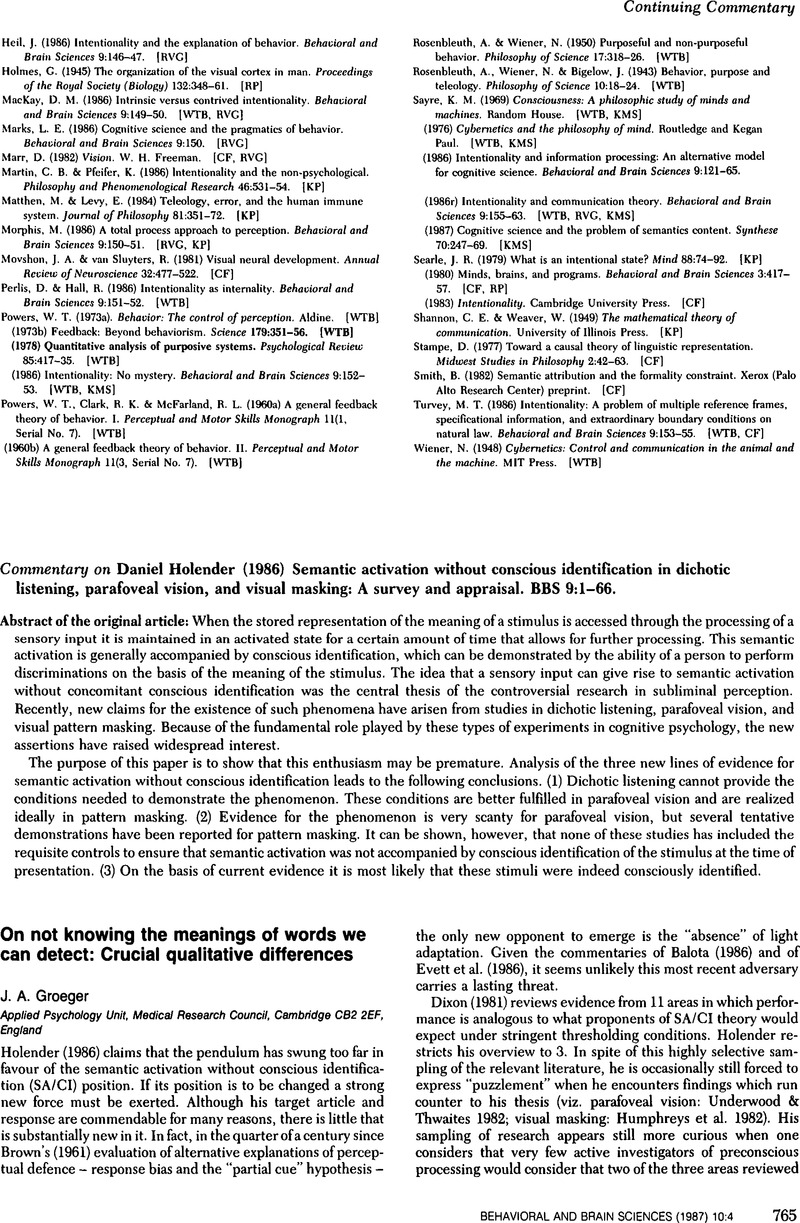Crossref Citations
This article has been cited by the following publications. This list is generated based on data provided by Crossref.
Skarda, Christine A.
1990.
The neurophysiology of consicousness and the unconscious.
Behavioral and Brain Sciences,
Vol. 13,
Issue. 4,
p.
625.
Limber, John
1990.
What's it like to be a gutbrain?.
Behavioral and Brain Sciences,
Vol. 13,
Issue. 4,
p.
614.
Holender, Daniel
1990.
On doing research on consciousness without being aware of it.
Behavioral and Brain Sciences,
Vol. 13,
Issue. 4,
p.
612.
Rey, Georges
1990.
Constituent causation and the reality of mind.
Behavioral and Brain Sciences,
Vol. 13,
Issue. 4,
p.
620.
Rosenthal, David M.
1990.
On being accessible to consciousness.
Behavioral and Brain Sciences,
Vol. 13,
Issue. 4,
p.
621.
Freidin, Robert
1990.
Grammar and consciousness.
Behavioral and Brain Sciences,
Vol. 13,
Issue. 4,
p.
605.
Schull, Jonathan
1990.
When functions are causes.
Behavioral and Brain Sciences,
Vol. 13,
Issue. 4,
p.
622.
Searle, John R.
1990.
Consciousness, explanatory inversion, and cognitive science.
Behavioral and Brain Sciences,
Vol. 13,
Issue. 4,
p.
585.
Young, Andrew W.
1990.
Consciousness, historical inversion, and cognitive science.
Behavioral and Brain Sciences,
Vol. 13,
Issue. 4,
p.
630.
Freeman, Walter J.
1990.
Consciousness as physiological self-organizing process.
Behavioral and Brain Sciences,
Vol. 13,
Issue. 4,
p.
604.
Bridgeman, Bruce
1990.
Intention itself will disappear when its mechanisms are known.
Behavioral and Brain Sciences,
Vol. 13,
Issue. 4,
p.
598.
Taylor, Charles
1990.
The possibility of irreducible intentionality.
Behavioral and Brain Sciences,
Vol. 13,
Issue. 4,
p.
626.
Lloyd, Dan
1990.
Loose connections: Four problems in Searie's argument for the “Connection Principle”.
Behavioral and Brain Sciences,
Vol. 13,
Issue. 4,
p.
615.
Dresher, B. Elan
and
Hornstein, Norbert
1990.
Language and the deep unconscious mind: Aspectualities of the theory of syntax.
Behavioral and Brain Sciences,
Vol. 13,
Issue. 4,
p.
602.
Glymour, Clark
1990.
Unconscious mental processes.
Behavioral and Brain Sciences,
Vol. 13,
Issue. 4,
p.
606.
Higginbotham, James
1990.
Searle's vision of psychology.
Behavioral and Brain Sciences,
Vol. 13,
Issue. 4,
p.
608.
Shevrin, Howard
1990.
Unconscious mental states do have an aspectual shape.
Behavioral and Brain Sciences,
Vol. 13,
Issue. 4,
p.
624.
Underwood, Geoffrey
1990.
Conscious and unconscious representation of aspectual shape in cognitive science.
Behavioral and Brain Sciences,
Vol. 13,
Issue. 4,
p.
628.
Meulen, Alice ter
1990.
The causal capacities of linguistic rules.
Behavioral and Brain Sciences,
Vol. 13,
Issue. 4,
p.
626.
McDermott, Drew
1990.
Zombies are people, too.
Behavioral and Brain Sciences,
Vol. 13,
Issue. 4,
p.
617.





